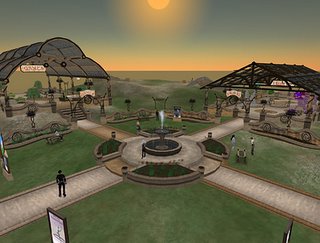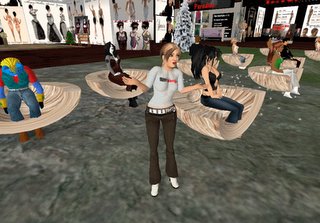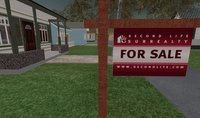Babbage Linden: ok, the big discussion that drove all this was about making SL easier to useAnd I have to agree: P2P teleporting will make SL easier to use. (I think P2P has many other disadvantages, but that's not the point here.) And while, IMHO, the importance of direct teleporting is grossly overrated, ease of use - or the lack of it - is maybe the most important factor for newbies giving up on SL in the first days or even hours.
Babbage Linden: at the moment loads of people are turning up, becoming bewildered
Babbage Linden: and never coming back
Babbage Linden: making SL easier is a big focus
Babbage Linden: to keep those people here
[...]
Babbage Linden: yes, newbies need to find what in SL appeals to them
Babbage Linden: but once they find it, they need to be able to get there easily
Babbage Linden: not find an event that sounds fun
Babbage Linden: and be teleported somewhere else
In my own portrait post on SLOG I already mentioned my own problems in the first days in SL. I don't want to generalize them too much. Maybe I am exceptionally clumsy. But I fear a lot of new users that are not too savvy with computer games in general or other online platforms like There or TSO will face similar hurdles. It may sound ridiculous to a seasoned resident, but Second Life is too damn hard for many first time users. The reasons are many:
- The client leaves much to be desired in terms of classical software usability.
- There is nothing much in the way of a tutorial.
- Online support is completely dependent on whom you accidentally meet in the WA or - similarly accidentally - contact through the help menu.
- There is not even a formal manual for the client and the "world". (No, a user-edited wiki does not count as a manual for a professional product.)
Many a youngster coming to SL with years of experience in early egoshooters or console games will snicker at these statements. A "tutorial"? LOL! "Manuals" for an online game? Christ, who needs that? Simple answer: many people in the most important target groups for SL! Lets face it: for the average player of console games SL is not a very attractive offering. The platform leaves much to be desired in the way of fast graphics, physics engine etc.
On the other hand SL is extremely attractive to people who like to communicate, to people who like to create, who don't want to slay monsters, who simply want to have a good time together with others - or alone, but in the context of a larger and complex world and society. That's why - compared to other PC games and online platforms - you'll find a high percentage of women and people with ages above the age of 30 (or even - OMG - above 40) in SL. These people are, BTW, an extremely attractive target group for Linden Lab. Why? First because they are a large - and growing - part of the internet population. Second: a lot of them have "money to spend". Third: for these people most other MMOGs and similar platforms are not really a competition (because of the personal preferences mentioned above). They only remaining competition currently seems to be There and TSO.
But - and that's a big "but" - many people in this promising target groups need more in their first days in SL. They need a client that is significantly easier to use. They need more in the way of up-front documentation. More in the way of guided tours, tutorials, how-tos - which could be implemented marvelously with the tools available in SL. More interactive support by real people. More "structure" to guide them through the first days. Some of these weaknesses are so obvious that I often did ask myself why Linden Labs seems to do so little in this direction.
 I suspect that this has got to do with the dogma of a society and a world mostly build by the residents themselves. This is a stated principle by Linden Lab - and has a lot of cost advantages, too (having hard working natives being paid with glass pearls). It worked fine for a while. But I am not sure if this will work in the significantly larger and fast-growing society of Second Life in the year 2006. Admitted, efforts like the Ivory Tower and similar offerings build by the residents are great. The greeter program is a fantastic achievement of the community. I bet the new Helper Island is great, too. But the quality and accompanying support fluctuates wildly. And all these programs do not attack the usability weaknesses of the client.
I suspect that this has got to do with the dogma of a society and a world mostly build by the residents themselves. This is a stated principle by Linden Lab - and has a lot of cost advantages, too (having hard working natives being paid with glass pearls). It worked fine for a while. But I am not sure if this will work in the significantly larger and fast-growing society of Second Life in the year 2006. Admitted, efforts like the Ivory Tower and similar offerings build by the residents are great. The greeter program is a fantastic achievement of the community. I bet the new Helper Island is great, too. But the quality and accompanying support fluctuates wildly. And all these programs do not attack the usability weaknesses of the client.All in all this is not a problem the most enthusiatic user community could handle. It is a job that should and can only be done by Linden Lab. There are some steps in the right direction I can see. But at least in the inworld activities I also still observe something that I fear is the attitude to get it done "as cheaply as possible" (= use non paid residents work wherever possible). And thats not the right way to set priorities, IMHO. Any Dollar invested in making Second Life more accessible to casual and non game-savvy users will come back manyfold.
Maybe I am prejudiced with this "ease of use" issue. Maybe that is because in my RL job I am often involved in usability improvement projects for large websites and development processes along the lines of "user centered design". Maybe ... On the other hand I have experienced exactly in these RL projects how important ease of use can be for an IT solution; especially if it is a system on the web, which is used by a large number of casual users. Little improvements in the front end or in some simple support process can lead to huge improvements in the retention rate or conversion rate. I wonder, if this really should be so much different in a platform like SL?
On the forums there is a lot of lively discussion about what features would make SL more appealing to "the masses". The usual suspects are "less lag", "more fps", "better physics/Havok2", "VoIP", "speed tree", "more stability", "try before you buy" etc. etc. And all this is probably true. But not one of this features will help much if Second Life as a whole - the client software and the support structures inworld and outworld - will not become easier to use for the newbie!












